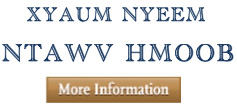The Reading & Writing Course
There are two reading writing courses, White Hmong and Green Hmong. Please register to have access to all PDF transcripts of each lesson.
Reading & Writing Courses
Introduction
The Hmong reading and writing is designed for Hmong high school students, college students, non Hmong, and any one who wish to learn to read and write in Hmong using the Romanized Popular Alphabet system. The course will focus on reading, writing, and pronunciation of letters and words in Hmong. Every words and text contents will also be translated into English for non Hmong who wish to learn the language and gain vocabulary while learning how to read and write. Students taking this course will learn the writing system in this order; tone markers, vowels, and consonants. As students learn the consonants, there will be a text content, vocabulary list, and a worksheet that comes with that consonant’s lesson. After every three or four lessons, there will also be a review and a test. The Green Hmong (Hmoob Ntsuab or Hmoob Leeg) will be offer once the White Hmong Reading & Writing course is finished.
Course Booklet
Students will learn to read and write from Father Yves Bertrais (Txiv Plig Nyiaj Pov)’s First Steps in Hmong (Xyuam Nyeem Ntawv Hmoob) booklet. This booklet is written only in Hmong with small text contents for each consonant. The majority of the contents will be the same from the booklet. But translations, worksheets, and tests will be issued for student to understand the contents and work along with each consonant’s lesson.
Learning Structure
The course is divided into 8 parts. Each parts contain about 3 or 4 lessons along with a test at the end of each part. Students will first learn all of the tone markers or vowels modifiers to understand and get all of the eight tones down right from the start. Students will then learn all of the 13 vowels with each vowel containing 8 different tones. Once students master the first part of tones and vowels, they will then learn about three consonants in every lesson. In each consonant’s lesson, there will also be a section of pronunciation where students must know how to pronounce the consonant, vowel, and the tone marker.
Worksheets
In each consonant’s lesson there will be a worksheet. Each worksheet contains four parts. The first part is translation and identifying correction translation. The second part contains creating sentences from using words from the text content. The third part contains creating new words without using words from the text content. The fourth contain reading comprehension, where students read a small text and answer questions. Later on the worksheet will also contain a writing section as well.
Tests
After every parts, there will be a test. The test contains a dictation of words and sentences, identifying correct translation of words, reading comprehension, and a writing portion. Recording for the dictation portion of the test will be at the end of the lesson before the test.
Audio Recording
Every lesson comes with an audio recording for the purpose of correct pronunciations of the letters and words.
Notes from the Author
Hmong college students, I want really to stress on how important it is to know how to read and write in Hmong. Many of us know that 90 percents of our Hmong doctorate graduates came back to work for the Hmong community, whether they establish their own business or working with other institutions. A lot of our college graduates also came back to work and get involve with the community. In my mind, it is really sad to see any young Hmong adult receiving a bachelor or master working with a Hmong community but doesn’t know how to read and write a single word in Hmong. Yet, we cannot even communicate correctly with our Hmong elders because our Hmong is so bad. I decided to teach and offer this course for the purpose of helping our Hmong youth to gain back Hmong literacy and be able to communicate well with our elders. Being able to read, write, and communicate with our Hmong community will benefit you very much if you’re still Hmong and if you’re planning to stay Hmong. But of course, this view is not in the perspective of many of our Hmong college students. Please, take the time now and learn little by little. Once you graduate from college, you won’t be worry about communicating well with our elders. An educated person must knows itself and its people before they can fully help others.
Xou Vang







